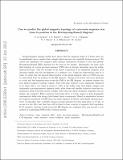Files in this item
Can we predict the global magnetic topology of a pre-main-sequence star from its position in the Hertzsprung-Russell diagram?
Item metadata
| dc.contributor.author | Gregory, Scott | |
| dc.contributor.author | -F. Donati, J. | |
| dc.contributor.author | Morin, J. | |
| dc.contributor.author | Hussain, Gaitee Ara Jaffer | |
| dc.contributor.author | J. Mayne, N. | |
| dc.contributor.author | A. Hillenbrand, L. | |
| dc.contributor.author | Jardine, Moira Mary | |
| dc.date.accessioned | 2016-11-17T16:30:12Z | |
| dc.date.available | 2016-11-17T16:30:12Z | |
| dc.date.issued | 2012-08-20 | |
| dc.identifier | 31079684 | |
| dc.identifier | 39a8ada2-93d1-4f5e-b112-293245af9268 | |
| dc.identifier | 84864660726 | |
| dc.identifier | 000307791400014 | |
| dc.identifier.citation | Gregory , S , -F. Donati , J , Morin , J , Hussain , G A J , J. Mayne , N , A. Hillenbrand , L & Jardine , M M 2012 , ' Can we predict the global magnetic topology of a pre-main-sequence star from its position in the Hertzsprung-Russell diagram? ' , Astrophysical Journal , vol. 755 , no. 2 , 97 . https://doi.org/10.1088/0004-637X/755/2/97 | en |
| dc.identifier.issn | 0004-637X | |
| dc.identifier.other | ArXiv: http://arxiv.org/abs/1206.5238v1 | |
| dc.identifier.other | BibCode: 2012ApJ...755...97G | |
| dc.identifier.other | ORCID: /0000-0002-1466-5236/work/57821812 | |
| dc.identifier.uri | https://hdl.handle.net/10023/9836 | |
| dc.description.abstract | ZDI studies have shown that the magnetic fields of T Tauri stars can be significantly more complex than a simple dipole and can vary markedly between sources. We collect and summarize the magnetic field topology information obtained to date and present Hertzsprung-Russell (HR) diagrams for the stars in the sample. Intriguingly, the large scale field topology of a given pre-main sequence (PMS) star is strongly dependent upon the stellar internal structure, with the strength of the dipole component of its multipolar magnetic field decaying rapidly with the development of a radiative core. Using the observational data as a basis, we argue that the general characteristics of the global magnetic field of a PMS star can be determined from its position in the HR diagram. Moving from hotter and more luminous to cooler and less luminous stars across the PMS of the HR diagram, we present evidence for four distinct magnetic topology regimes. Stars with large radiative cores, empirically estimated to be those with a core mass in excess of ~40 per cent of the stellar mass, host highly complex and dominantly non-axisymmetric magnetic fields, while those with smaller radiative cores host axisymmetric fields with field modes of higher order than the dipole dominant (typically, but not always, the octupole). Fully convective stars stars above ~0.5 MSun appear to host dominantly axisymmetric fields with strong (kilo-Gauss) dipole components. Based on similarities between the magnetic properties of PMS stars and main sequence M-dwarfs with similar internal structures, we speculate that a bistable dynamo process operates for lower mass stars (<~0.5 MSun at an age of a few Myr) and that they will be found to host a variety of magnetic field topologies. If the magnetic topology trends across the HR diagram are confirmed they may provide a new method of constraining PMS stellar evolution models. | |
| dc.format.extent | 775804 | |
| dc.language.iso | eng | |
| dc.relation.ispartof | Astrophysical Journal | en |
| dc.subject | Hertzsprung-Russell and C-M diagrams | en |
| dc.subject | Stars: evolution | en |
| dc.subject | Stars: formation | en |
| dc.subject | Stars: interiors | en |
| dc.subject | Stars: magnetic field | en |
| dc.subject | Stars: pre-main sequence | en |
| dc.subject | QB Astronomy | en |
| dc.subject | QC Physics | en |
| dc.subject.lcc | QB | en |
| dc.subject.lcc | QC | en |
| dc.title | Can we predict the global magnetic topology of a pre-main-sequence star from its position in the Hertzsprung-Russell diagram? | en |
| dc.type | Journal article | en |
| dc.contributor.sponsor | Science & Technology Facilities Council | en |
| dc.contributor.institution | University of St Andrews. School of Physics and Astronomy | en |
| dc.identifier.doi | 10.1088/0004-637X/755/2/97 | |
| dc.description.status | Peer reviewed | en |
| dc.identifier.url | http://adsabs.harvard.edu/abs/2012ApJ...755...97G | en |
| dc.identifier.grantnumber | ST/J001651/1 | en |
This item appears in the following Collection(s)
Items in the St Andrews Research Repository are protected by copyright, with all rights reserved, unless otherwise indicated.

